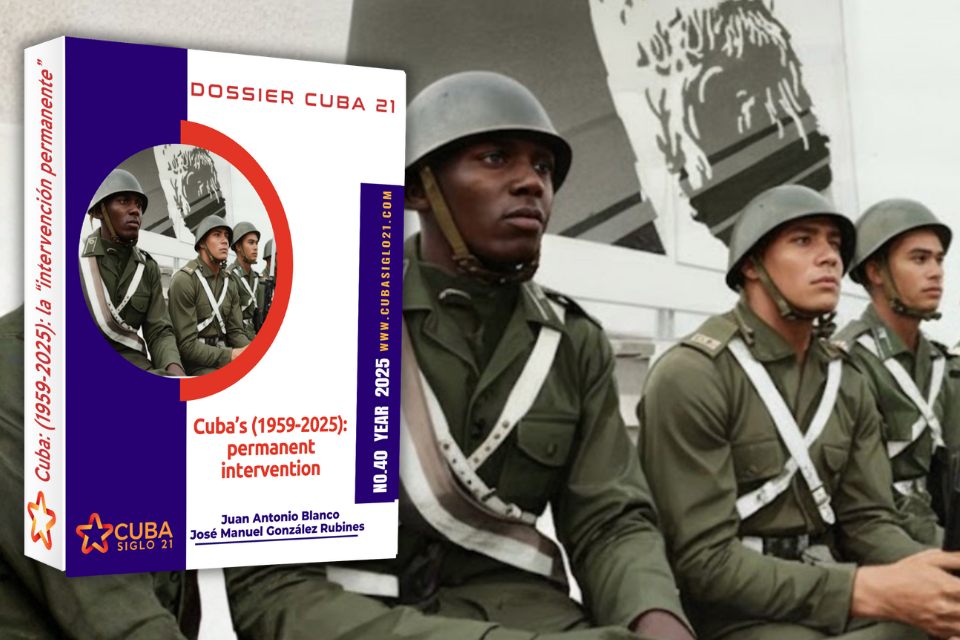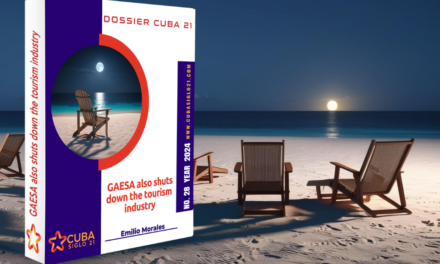Descargar informe completo en español
Download report in English
From irregular, to conventional, to hybrid warfare
Executive Summary
- A review of Cuba’s international interventions since 1959 reveals a consistent pattern of aggressive foreign policy motivated, by ideological reasons, by the strategic needs posed by the Castro regime’s economic dependence—as it proved incapable of building a solid economy—and by its decision to ally itself with totalitarian, dictatorial, and anti-American regimes in order to project an international influence out of all proportion and obtain subsidies and collaboration from them. Under this same logic, Cuban interventionism has served Havana to sabotage offers to improve relations with the US in some cases or even normalize them in others made by several US administrations (especially those of Ford/Kissinger, Carter, Clinton, Obama, and Biden).
- The Cuban government intervenes or participates directly (with military, civilian, or covert personnel) when it perceives an opportunity to destabilize a democratic regime and/or support an anti-American allied government. When these interventions were successful in immediate military or political terms (i.e., Angola in 1975, Ethiopia in 1977, Nicaragua in 1979, Venezuela in 1999), they resulted in regime changes followed by the establishment of brutal authoritarian single-party systems and, often, personalistic leadership that lasted for decades. Chile (1970-1973) was a first failed attempt at definitively seizing power after a sympathetic government came to the presidency. The formula? Install a political group under its influence through elections, remove hostile military commanders or, failing that, create a military structure parallel to the institutional one, and finally change the Constitution and refound the nation with institutions that allow the new satellite government and its allied groups to remain in power. Decades later, after failing in Chile, they would successfully repeat that same formula in other countries such as Venezuela, Bolivia, Ecuador, and Honduras, and now they are rushing to complete it in Colombia. Curiously, all of them together were the perfect launchpad for drug cartels’ production and export activities.
- Many of these regimes supported by Cuba have engaged in massacres, torture, and iron-fisted political control, from the May 1977 massacre in Angola, to the Red Terror in Ethiopia (1977-1978) with tens of thousands of deaths, to the contemporary repression in Venezuela and Nicaragua with hundreds of murders of opponents and thousands of political prisoners. In all these cases, Cuba was instrumental in installing a criminal regime and then sustaining it by providing the tools of power that allowed them to prevail over their adversaries at any human cost.
- For the populations of the intervened countries, the consequences have been devastating. Angola and Ethiopia suffered prolonged wars with more than 1 million combined deaths, which set back their development for generations. Latin America experienced cycles of insurgency and counterinsurgency in which tens of thousands lost their lives, fueled by Cuba’s subversive armed intervention and the military reactions and brutal coup de Etat it provoked.
- For the Cuban people, the interventionist policy entailed enormous internal sacrifices: thousands of families lost children in distant wars, and vital economic resources were diverted to these adventures in cases where they did not receive direct and massive support from the USSR. Added to this are the diplomatic opportunities lost—or consciously sabotaged—by the Cuban leadership (especially Fidel Castro) to normalize political, diplomatic, and economic relations with the US and other countries, the consequences of which have chronically affected the population.
- Cuba’s military, security, and intelligence spending for more than six decades (the Cuban regime had one of the largest armies and security and intelligence apparatuses in Latin America in the 1980s, disproportionate to its GDP as well as its territorial and demographic size) was a burden on the domestic economy, and the unregulated autonomy of these sectors turned out to be the seed of the current mafia state run company known as GAESA.
- Conventional warfare in Africa since 1975 strained East-West relations, affecting congressional ratification of strategic arms agreements between the USSR and the US and nearly provoking a large-scale direct confrontation with South Africa.
- Recently Ukrainian intelligence has documented the participation of thousands of Cubans in the Russian imperialist aggression against their country. Additionally, it is known that Cuban special forces located in Belarus, a country bordering Ukraine, under the pretext of training in the art of modern warfare (the same argument given by North Korea for sending soldiers to fight against the Ukrainians), have been strategically placed in that country a few kilometers from the European war zone. In 2025, Ukraine closed its embassy in Cuba and denounced the island’s government for its support of Russian aggression against its country.
- Over six decades, the Cuban regime’s interventionist policy has never ceased—not even during the crisis of the 1990s or the current one—, although it has taken various shapes. During that time, it has employed different forms of military projection and destabilization: from irregular warfare (rural and urban guerrillas) to conventional warfare (with regular units of the Armed Forces), as well as variants of hybrid warfare, even participating in high-intensity conflicts such as that in Ukraine. In Latin America, the application of hybrid warfare has been based on the use of criminal and extreme left-wing groups to exploit existing social conflicts—often legitimate ones—in democratic countries, with the aim of generating episodes of violence that provoke state repression, which is then used to articulate broad anti-government propaganda campaigns promoted by agents of influence planted in the media, political circles, trade unions, academia, and intellectual circles. To this end, the regime also draws on its extensive international media network—coordinated with those of its allies such as Russia, China, and Venezuela—its agents of influence, and its vast diplomatic and intelligence infrastructure deployed around the world.
- Only a transition from the present totalitarian and mafia-like Cuban regime to an open, democratic society with the rule of law and a free market will put an end to the inadequacy of the national economy and open the way to prosperity. Only a change of that criminal regime will put an end to a warmongering foreign policy that, in an opportunistic manner—to gain subsidies and external alliances—has threatened the national security of countries in the Western Hemisphere and other regions of the world for more than six decades.
Conclusions
- Cuban interventionism and its constant threat to US security are not a foreign policy option among others, nor do they stem from the messianic delusions of its leaders but are also determined by a failed economic system that requires constant and disproportionate external subsidies. In order to obtain international resources that contribute to internal stability, Cuba resorts to generating international instability in the service of a patron (be it the USSR, Venezuela, Russia, or China) and collaborates in the joint acquisition and/or sale of intelligence to countries hostile to the West, such as those already mentioned, as well as others such as Iran and the Democratic People’s Republic of Korea. The legacy of Cuban interventionism suggests that it was rarely confronted firmly by the US and other governments. The failed approach that allowed this long and dangerous Cuban interventionism was based on the false premise that it was possible to modify the behavior of the Cuban government with sanctions or incentives without un ly pushing for its removal or the change of the failed governance regime on which it relies.
- Cuba’s interventionist policy is not a thing of the past. It is an active reality in the present, despite the colossal social and economic disaster that Cuba is currently experiencing. The unlimited resources that came from the USSR and the agreement with that now-defunct power to carry out these activities for almost four decades are now obtained by Cuba from its alliances with regimes that it has supported—such as Venezuela—criminal cartels, and radical terrorist groups. Cuba was behind Diosdado Cabello’s so-called “Bolivarian breezes” of 2019, planned to unleash large-scale social conflicts in Ecuador, Colombia, Venezuela, and Chile. It should come as no surprise to anyone that, given the current escalation of confrontation between the US and Caracas, they seem determined to create other hotbeds of conflict in countries in the region. Havana has also not abandoned its policy of using civilian medical and other missions to cover up intelligence agents and their operations in other countries, including collusion with organized crime elements.
- Cuba’s interventionist strategy over the last six decades has installed autocratic and often criminal elite regimes that—with Havana’s help—consolidate exclusionary power structures, with enormous costs in terms of human rights and social welfare and engage in transnational organized crime. For them—as for the military oligarchy of the GAESA oligopoly in Cuba—what counts is not political ideology but the size of the business deal.
- Only a change from Cuba’s present totalitarian and mafia-like regime to an open, democratic society with the rule of law and a free market will put an end to the national economy’s shortcomings and open the door to prosperity. Only a regime change towards democracy, the rule of Law and a free market economy will put an end to a warmongering foreign policy that, in an opportunistic manner—to gain subsidies and external alliances—has threatened the national security of countries in the Western Hemisphere and other regions of the world for more than six decades.







